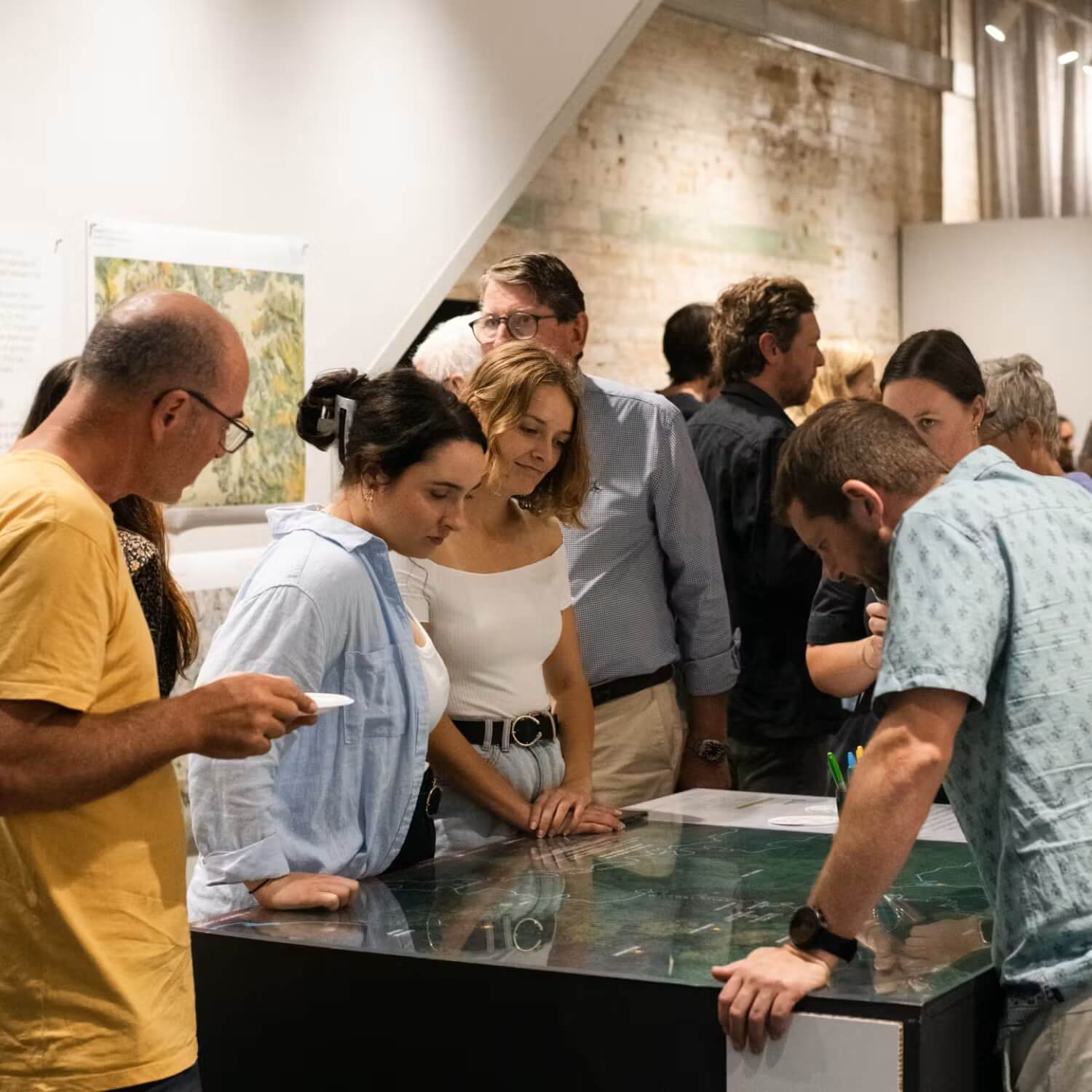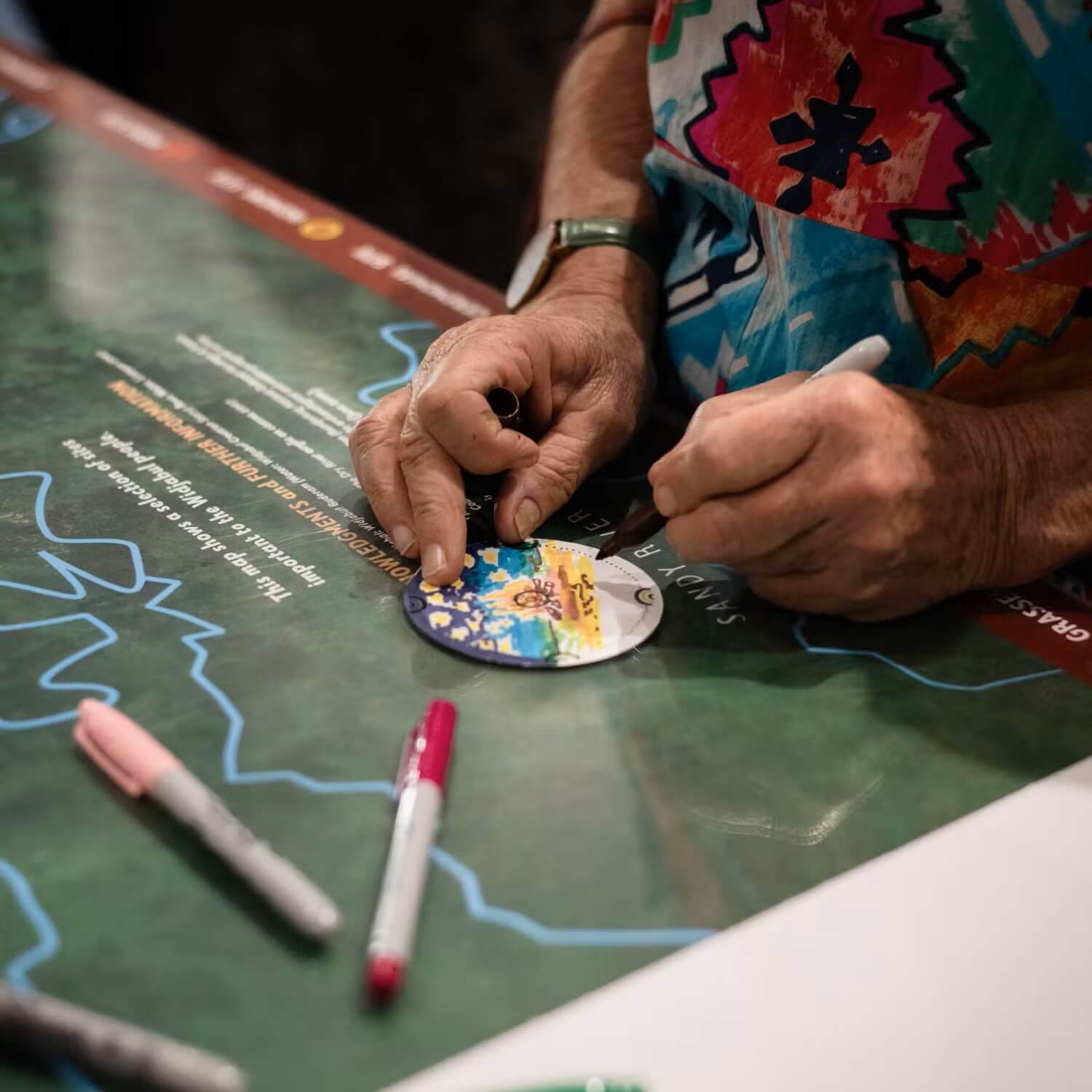About this case study
Biodiversity loss, extreme weather events
Land and water managers, communities
Community engagement
For the Bundjalung people of the Northern Rivers, humans are not at the centre of the ecosystem – they are part of it.
We all feel a connection to landscapes. But we don’t always recognise the knowledge systems that shape how we think about them.
Dan Etheridge, Engagement Director, Living Lab Northern Rivers
Planners, designers and policy-makers are often reminded to “put people at the centre” of their work. This is at odds with the Country-centred worldview of First Nations people that sees humans as participants in a living system.
This important distinction formed the basis of Tracing the Past, Shaping the Future, a public exhibition created by Living Lab Northern Rivers and staged in Lismore in the wake of the 2022 floods.
“The extreme events of the 2022 floods forced people to revisit the plans they had for their lives and our region’s future,” says Dan Etheridge, Engagement Director at Living Lab Northern Rivers.
Amid the devastation, something new took root. Community conversations “over many cups of tea” drew out a consistent theme: a desire to shape Lismore’s future through Indigenous Knowledges and culture.
But what does it really mean to work with Indigenous Knowledges?
Tracing the Past, Shaping the Future invited visitors to examine the transformation of our physical environment from pre-colonial times, contrasting the Bundjalung people's Country-centred worldview with Eurocentric human-centred perspectives.
Focused on Widjabul Wia-bal Country, the exhibition brought together maps, landscape sections, plant stories and case studies to demonstrate how Indigenous Knowledges shape resilient landscapes.
Developed in partnership with Jagun Alliance, Zion Engagement and Planning, Agency in Design and ReconEco, Living Lab Northern Rivers created a space for the community to engage with Country-centred thinking.
“As we look ahead it is important to take the time to consider where we are looking from,” Dan notes.
A different way of seeing
Aboriginal communities and the NSW Government developed the first Connecting with Country Framework in 2020. This recognises that Country isn’t just land – it is a living, interconnected system that includes the people, plants, animals, water and sky.
The diagram below is a simple representation of a complex idea, illustrating the fundamental difference between human-centred and Country-centred worldviews.
The former places humans above all other life in a hierarchy. The latter sees humans as one part of a circular network of integrated relationships.
To ground these worldviews, Tracing the Past, Shaping the Future used vegetation mapping to show the plant communities pre-1842 and those that exist today. One map revealed a diverse mosaic of culturally managed ecosystems; the other fragmented landscapes.
The exhibition invited people to stop, and acknowledge their own starting point, to learn from the past so we can begin a new healthier discourse about our stewardship of the land.
Dan Etheridge, Engagement Director, Living Lab Northern Rivers
To explore these perspectives further, cross-sections of plant communities were developed by designer Mackenzie Saddler in collaboration with local ecologists and Traditional Owners. One represented plants by their taxonomic identity; the other by their relationships to other plant communities.
“Both the local ecologists and Traditional Owners wanted to learn from each other,” Dan notes. Aboriginal and Western Knowledge systems have much in common. Both rely on observation, experimentation, recognising patterns, testing ideas and drawing on creativity and intuition. “Each way of knowing offers valuable insights into how we interpret and connect with landscapes.”
In parallel with the exhibit, Living Lab Northern Rivers ran workshops with the NSW Reconstruction Authority, using an interactive art-based approach to help staff engage with Country-centred principles.
Deep roots, enduring stories
The exhibition also encouraged visitors to consider how native plants shape Bundjalung Country’s past, present and future.
The Bugam tree, or Black Bean, has sustained Indigenous communities for more than 2,000 years. Its seeds, carried along Songlines and Dreaming tracks, were toxic if eaten raw, but edible when carefully processed into bush damper.
The Macadamia tree, native to Bundjalung Country, produces one of the world’s most prized nuts. While first commercialised in Hawaii in the 1880s, Australia reclaimed its place as the world’s largest macadamia producer in the late 20th century.
The Brush Box was central to Australia’s first forest blockade at Terania Creek in 1979 – a protest that led to the creation of Nightcap National Park in 1983 and later recognition as part of the Gondwana Rainforests World Heritage Area.
Living Labs Northern Rivers hopes to open new doors to different conversations about land management and climate adaptation.
“We have a very clear set of recent experiences that show us how European approaches to land management have often contributed to the extremity of natural disasters, with devastating outcomes for Country and the broader community,” Dan says.
Related content

The importance of the land to wellbeing cannot be understated, which is why strategies to combat and manage the impacts of climate change are crucial. Aboriginal people have been using generational knowledge of land and sea management in response to changing climates over thousands of years.

A key priority of the NSW Marine Estate Management Strategy (MEMS) is to improve water quality and reduce marine litter – and reinstating our long-forgotten oyster reefs has a huge role to play in meeting this priority while helping NSW coastal communities adapt to climate change.

Aboriginal people bring a unique perspective to the climate change conversation, informed by over 70,000 years of close observation and relationship with the environment. This collaborative project between the Narran Lakes Joint Management Committee and Worimi Lands Conservation Board explores this knowledge to find cultural solutions to understand and live with climate change.


